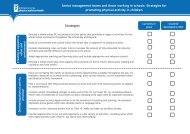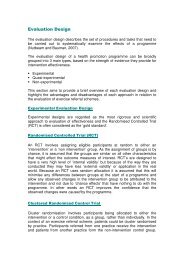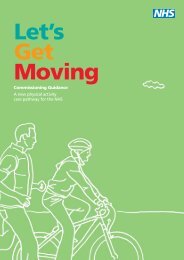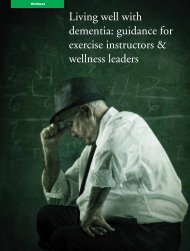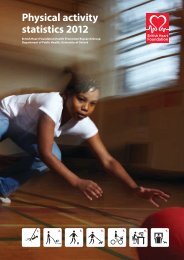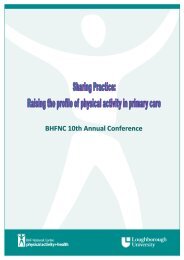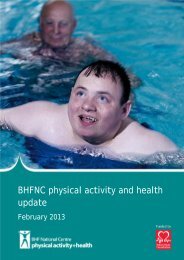Sedentary behaviour evidence briefing - BHF National Centre ...
Sedentary behaviour evidence briefing - BHF National Centre ...
Sedentary behaviour evidence briefing - BHF National Centre ...
You also want an ePaper? Increase the reach of your titles
YUMPU automatically turns print PDFs into web optimized ePapers that Google loves.
Evidence Briefing<br />
11<br />
Actions for policy makers<br />
• Policy-makers from various disciplines, including<br />
health, education, welfare, occupational health<br />
and social development, should be aware of the<br />
importance of reducing sedentary <strong>behaviour</strong>s.<br />
• Action should be taken to reduce the potential<br />
health risks associated with sedentary <strong>behaviour</strong><br />
through policy measures.<br />
• <strong>Sedentary</strong> <strong>behaviour</strong> reduction should be a standard<br />
policy item in guidance documents on health.<br />
• Assess in advance what impact (both intended and<br />
unintended) any policy proposals are likely to have<br />
on sedentary <strong>behaviour</strong>.<br />
• Provide educational opportunities on sedentary<br />
<strong>behaviour</strong> for different professional groups who can<br />
help reduce this <strong>behaviour</strong>.<br />
• Policy makers should support and encourage<br />
employers to take steps to minimise sedentary<br />
<strong>behaviour</strong>s in employees, including regular breaks<br />
from sitting at a computer.<br />
• Policy makers should support and encourage schools<br />
to consider how they can reduce extended periods<br />
of sitting for pupils.<br />
Actions for practitioners<br />
• Practitioners working in various disciplines,<br />
including primary care, welfare, education and<br />
occupational health, should review their knowledge<br />
and understanding of the health risks associated<br />
with sedentary <strong>behaviour</strong>.<br />
• Action should be taken to minimise risk in the<br />
practitioner’s target audience.<br />
• All age groups (children, younger people, adults and<br />
older adults) should be educated on the potential<br />
health risks of sedentary <strong>behaviour</strong> and be provided<br />
with strategies they can adopt to break up their<br />
sedentary time.<br />
• Regular active breaks should be encouraged during<br />
work and school time.<br />
• During leisure-time, active breaks should focus<br />
upon times of day when sedentary <strong>behaviour</strong>s are<br />
most likely to occur, such as after school or work,<br />
evenings, weekends and during holidays.<br />
• Practitioners should promote and help develop<br />
strategies which encourage families to set rules or<br />
‘quotas’ on screen-time and remove TVs or video<br />
game machines from bedrooms.<br />
• Practitioners working with parents/carers should<br />
encourage them to limit the amount of time young<br />
children are restrained in highchairs, pushchairs or<br />
car seats.<br />
• Practitioners should encourage parents to be<br />
good role models by reducing personal sedentary<br />
<strong>behaviour</strong>.<br />
• Practitioners should implement robust monitoring<br />
and evaluation of local programmes.<br />
Making physical activity a priority



